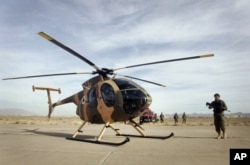The Afghan air force will not reach necessary strength levels until 2020, according to a top U.S. general.
General John Campbell, who ended his command of U.S. and NATO troops in Afghanistan last week, told reporters Friday that some aircraft procured for the force would not arrive in Afghanistan until 2018.
The force would then need an additional two to three years to train the pilots needed for the new aircraft, he explained.
"2020 is probably a good guess," Campbell said.
Afghan aviation capabilities saw significant progress in the 18 months in which the general led international forces there, although, he said, the United States "started way too late" in developing the nation's air force.
For example, in 2014, the Afghan air force conducted 85 aerial support missions; in 2015, that number increased to 4,485.
Future improvements
The force will double the number of A-29 turboprop attack aircraft in the next couple of weeks, according to Campbell. It will also add eight to 10 MD-530 armed helicopters — which the general referred to as "little birds" — to the Afghan air arsenal this fighting season.
"Those have made a difference in Nangahar, in Helmand," he said.
However, the United States and NATO must still build, train and advise Afghan attack controllers needed to direct the action of their combat aircraft during offensive operations.
These controllers are required to positively identify targets and help prevent civilian casualties.











